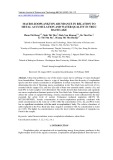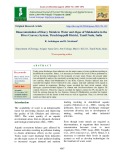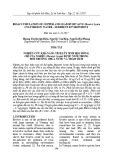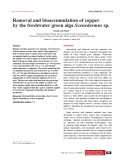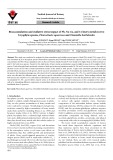
Bioaccumulation of copper
-
Urban lake pollution is one of the serious issues due to suffering of waste discharged from householders. However, there is a gap of knowledge about the diversity of zooplankton species and how metals accumulate in zooplankton in urban ecosystems. We addressed this by determining the rule of blooming macro-zooplankton in the Truc Bach lake and levels of two essential metals: copper (Cu), and zinc (Zn) and of three non-essential metals: arsenic (As), and lead (Pb) in water samples were determined.
 8p
8p  angicungduoc5
angicungduoc5
 13-06-2020
13-06-2020
 8
8
 0
0
 Download
Download
-
Today water discharges from industries are the major causes of water pollution resulting in destabilized ecosystems. Hence, it is necessary to monitor the levels of these pollutants as well as develop technologies for the treatment of waste water. Hence, the present study was attempted to analyse the commonly occurring heavy metals in water and organisms in two stations, Musiri and Mukkombu of the River Cauvery.
 6p
6p  trinhthamhodang4
trinhthamhodang4
 22-03-2020
22-03-2020
 13
13
 1
1
 Download
Download
-
Study on raising Meretrix lyrata (M.lyrata) clam in medium containing copper (Cu) and lead (Pb) at different concentrations for 28 days to assess the bioaccumulation ability of needles This type of clam into the body. Clam culture environment is prepared by dissolving metal into the water phase of rearing tanks (containing seawater, sediment and clam collected from Tien river estuary in Tan Thanh commune, Go Cong Dong district, Tien Giang province). with initial concentrations: 30 µg Cu / L and 50 µg Pb / L (abbreviated to 30Cu-50Pb), 60Cu-150Pb, 100Cu-300Pb and 200Cu-600Pb.
 7p
7p  khidoichuoi
khidoichuoi
 04-03-2020
04-03-2020
 14
14
 1
1
 Download
Download
-
Human activities generate vast amounts of wastewater, which contains various toxic metals. Microalgae are able to remove heavy metals from wastewater and accumulate lipid to produce biodiesel. In this study, the abilities to remove copper (Cu) and accumulate lipid of the green algal species Scenedesmus sp. were examined. The microalga Scenedesmus sp. was exposed to Cu concentrations of 0, 0.5, 1, 2, 5, and 10 mg/l under laboratory conditions. The results indicated that Cu inhibited the growth of Scenedesmus sp. at a 96hEC50 of 7.54 mg/l. Furthermore, the highest removal rate was 89.5%.
 6p
6p  caygaocaolon1
caygaocaolon1
 13-11-2019
13-11-2019
 31
31
 1
1
 Download
Download
-
This study was conducted to evaluate the bioaccumulation and oxidative stress impact of lead (Pb), nickel (Ni), copper (Cu), and chromium (Cr) in bryophyte species Pleurochaete squarrosa and Timmiella barbuloides exposed to Pb, Ni, Cu, and Cr at 1 mM concentration for 48 h.
 12p
12p  caplock2711
caplock2711
 21-02-2019
21-02-2019
 9
9
 0
0
 Download
Download
-
Copper fungicides are environmentally unfriendly. They are very toxic to fish and aquatic invertebrates, such as crab, shrimp and oysters. There are cases where most animal life in soil, including large earthworms, have been eliminated by the extensive use of copper-containing fungicides in orchards. It is strongly bioaccumulated and is very persistent. Once a soil is contaminated with copper, there is no practical way to remove it. The organic insecticide rotenone has been found to be toxic to pigs, rats and dogs and is is very toxic to fish. It causes skin and eye irritations.
 15p
15p  cao_can
cao_can
 02-01-2013
02-01-2013
 31
31
 3
3
 Download
Download
CHỦ ĐỀ BẠN MUỐN TÌM








